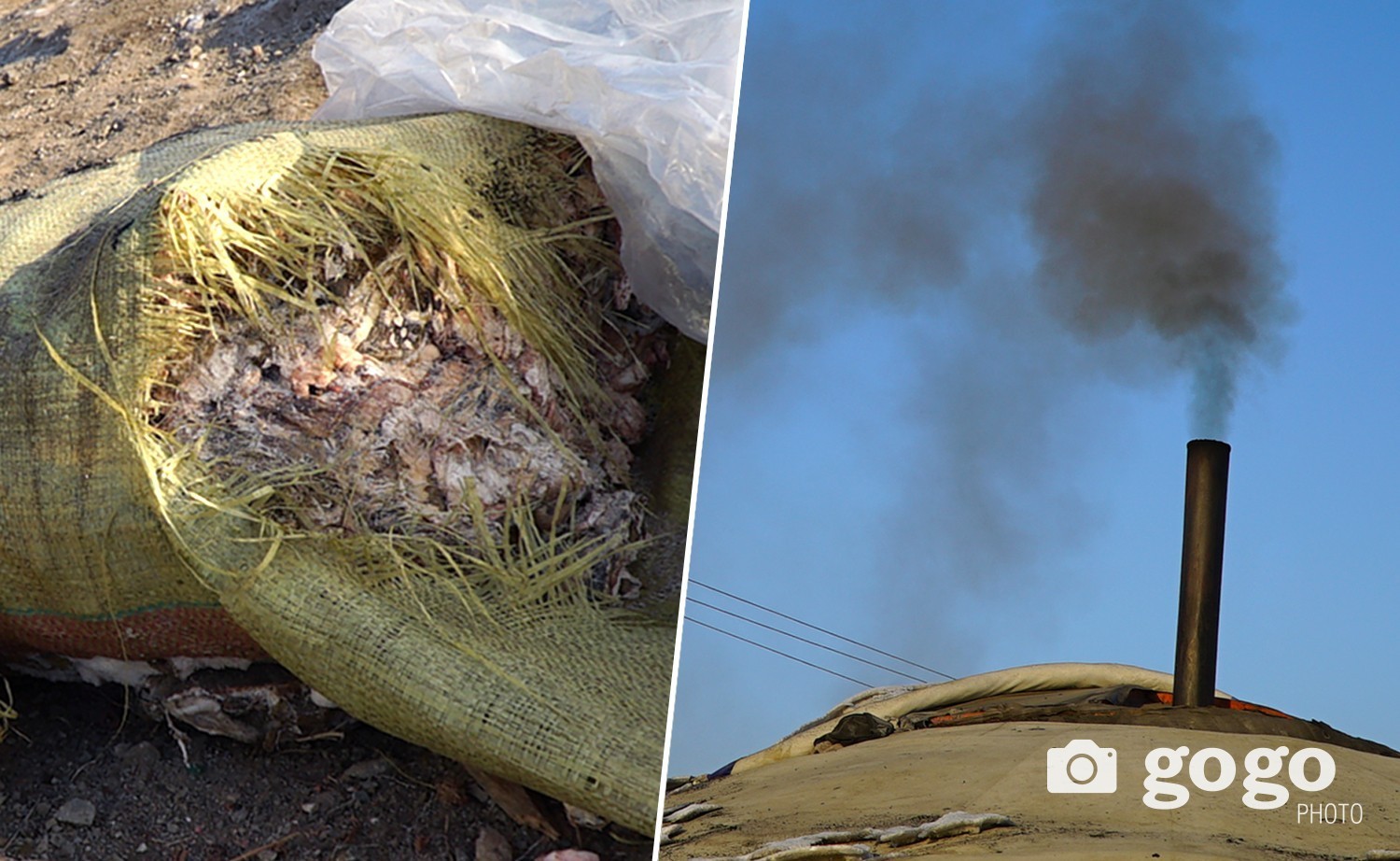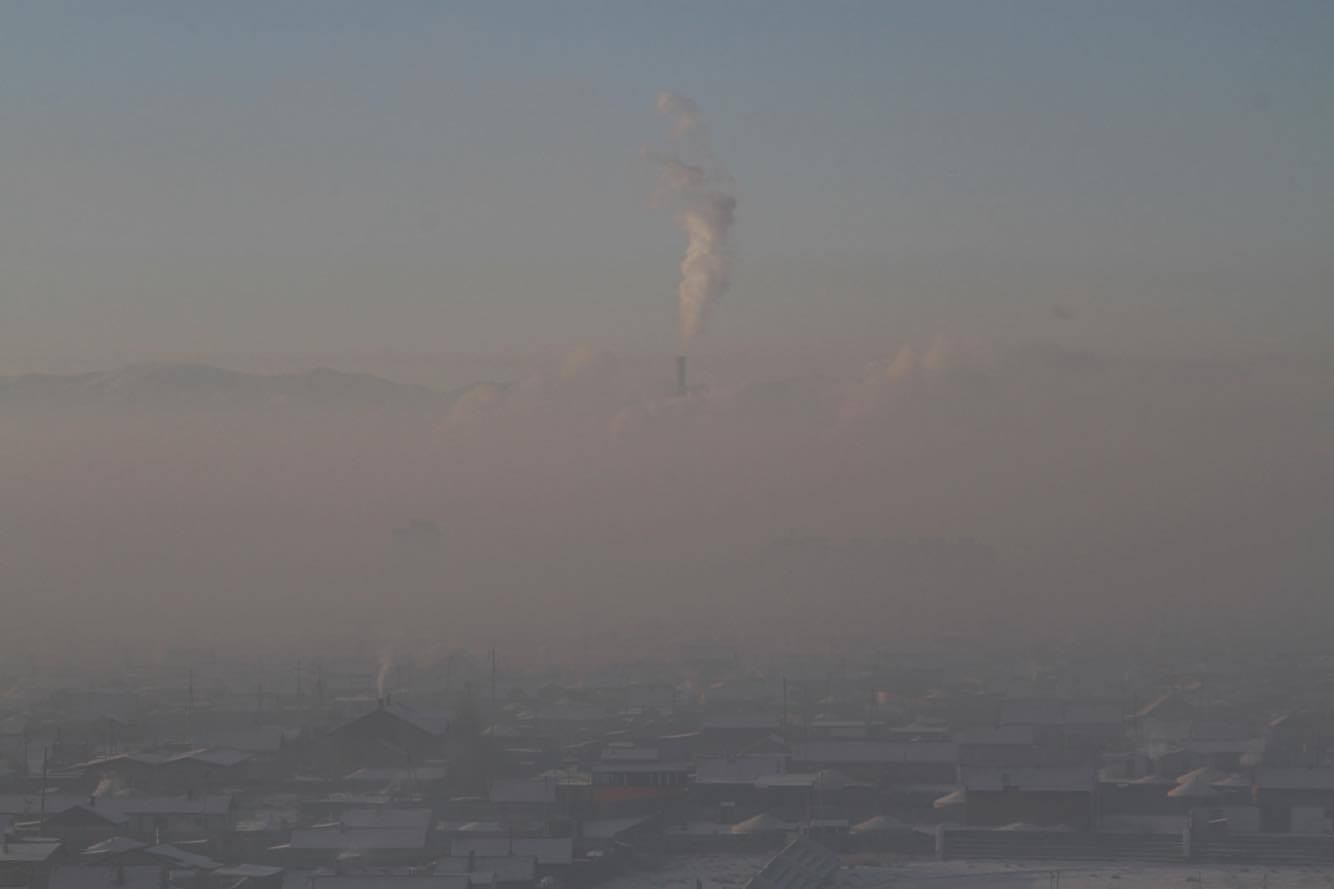Air pollution has soared to hazardous levels in the most areas of Ulaanbaatar city, exceeding 120 times the limit, as compared with the World Health Organization safe level of 25.
Today levels of PM2.5 particulates, which are the most hazardous to health, are reaching 3000 micrograms per cubic meter in heavily polluted areas of the city.
Ulaanbaatar, the capital city of Mongolia is home to about 1,372,000 residents.
Every winter, residents of Ulaanbaatar city are suffering from hazardous levels of air pollution caused by rising ger districts, where people live with no access to central heating system and rely on coal-burning stoves to survive temperatures that fall below minus 35 degrees Celsius.
80 percent of air pollution comes from those ger district households.
Result of the study conducted by the end of 2015 reveals that Ulaanbaatar city has 214 thousand ger district households, of which 30 percent of them burn items that are extremely harmful to human health such as, animal fat, plastic ware and old tires. Those are families with low income, fighting with cold to survivie.

Air pollution of the Ulaanbaatar city has been in the center of discussions for ten years. However, this year the issue has lead to positive outcomes due to rising public voices.
On Dec 26th, 2016, over 4000 Mongolian parents gathered at the Sukhbaatar Square for the well-being of children, demanding the government to take immediate and efficient actions. It was the first ever demonstration of citizens against air pollution in the history. Parents have decided to demonstrate again under the slogan "We are mad as hell" on Jan 28.
Moreover, media organizations have joined their forces against air pollution and starting to raise the pollution issue through different media platforms.
The Government has spent MNT 135 billion on reducing air pollution in the last few years, implementing inefficient programs.
Such public voices and continous demand have pressured decision makers, resulting to take following actions on tackling air pollution;
FREE NIGHTTIME ELECTRICITY FOR GER DISTRICT HOUSEHOLDS
On Dec 28, 2016, the Government has approved a regulation to cut electricity night tariff for ger district households to zero, especially from 9pm to 6am, aiming at reducing air pollution of the Ulaanbaatar city. The regulation has applied starting Jan 1, 2017.
Over 146 thousand residents, living in ger district are able to subject to free nighttime electricity by installing electricity meter with dual-tariff equivalents.
However, some households living in ger district cannot afford the electricity meter with dual-tariff equivalents, which costs about 90,000 MNT as well as electric heater with prices starting from 200,000 MNT.
DECREASE THE USE OF RAW COAL
Ministry of Environment and Green Development is working to replace coal-burning stoves with improved stoves which produce less smoke and to offer briquettes to poor households. According to the study, the action is expected to reduce air pollution by 10 percent.
City Governor`s Office reports that about 10 brickette manufacturing plants are operating in Mongolia. For instance, Mon Watt LLC has performed experiment on German technology for two years, which can produce heat for 16 hours a day, accumulating cheap electricity at night.
Previously, the Government implemented "Coal" program and distributed raw coal with low cost. However, experts say that this action increased the air pollution.
LIMITED MIGRATION TO ULAANBAATAR CITY FROM RURAL AREAS
On Jan 9, City Mayor and City Governor S.Batbold has issued an order to stop migration to Ulaanbaatar, the capital city of Mongolia from rural areas until Jan 1, 2018, aiming to reduce air pollution.
Most of those people living in ger districts are migrants from the countryside to city, seeking for better lifestyle, education and job.
According to the order, people in need of long-term treatment in Ulaanbaatar city and people who purchased housing in Ulaanbaatar city are allowed migrate to the city.
In other cases, migration of people from rural areas to Ulaanbaatar city is banned.

Air pollution of Ulaanbaatar city has increased by 30 percent within a year between 2015 and 2016. Residents of the city are at the danger of fatal health issues caused by air pollution, if officials will not take immediate and efficient actions this year.
According to the study conducted among the capital city, air pollution causes exacerbate pneumonia in children and cardiovascular disease in adults. Preliminary results from the Smoke Randomized Intervention Study of Air Pollution and Fetal Growth show that 130 children and 1400 adults die from air pollution in Ulaanbaatar city annually.
Even the National Security Council led by the President accepted the sitaution and admitted that air pollution in Ulaanbaatar reached to disaster level.
Air pollution has soared to hazardous levels in the most areas of Ulaanbaatar city, exceeding 120 times the limit, as compared with the World Health Organization safe level of 25.
Today levels of PM2.5 particulates, which are the most hazardous to health, are reaching 3000 micrograms per cubic meter in heavily polluted areas of the city.
Ulaanbaatar, the capital city of Mongolia is home to about 1,372,000 residents.
Every winter, residents of Ulaanbaatar city are suffering from hazardous levels of air pollution caused by rising ger districts, where people live with no access to central heating system and rely on coal-burning stoves to survive temperatures that fall below minus 35 degrees Celsius.
80 percent of air pollution comes from those ger district households.
Result of the study conducted by the end of 2015 reveals that Ulaanbaatar city has 214 thousand ger district households, of which 30 percent of them burn items that are extremely harmful to human health such as, animal fat, plastic ware and old tires. Those are families with low income, fighting with cold to survivie.

Air pollution of the Ulaanbaatar city has been in the center of discussions for ten years. However, this year the issue has lead to positive outcomes due to rising public voices.
On Dec 26th, 2016, over 4000 Mongolian parents gathered at the Sukhbaatar Square for the well-being of children, demanding the government to take immediate and efficient actions. It was the first ever demonstration of citizens against air pollution in the history. Parents have decided to demonstrate again under the slogan "We are mad as hell" on Jan 28.
Moreover, media organizations have joined their forces against air pollution and starting to raise the pollution issue through different media platforms.
The Government has spent MNT 135 billion on reducing air pollution in the last few years, implementing inefficient programs.
Such public voices and continous demand have pressured decision makers, resulting to take following actions on tackling air pollution;
FREE NIGHTTIME ELECTRICITY FOR GER DISTRICT HOUSEHOLDS
On Dec 28, 2016, the Government has approved a regulation to cut electricity night tariff for ger district households to zero, especially from 9pm to 6am, aiming at reducing air pollution of the Ulaanbaatar city. The regulation has applied starting Jan 1, 2017.
Over 146 thousand residents, living in ger district are able to subject to free nighttime electricity by installing electricity meter with dual-tariff equivalents.
However, some households living in ger district cannot afford the electricity meter with dual-tariff equivalents, which costs about 90,000 MNT as well as electric heater with prices starting from 200,000 MNT.
DECREASE THE USE OF RAW COAL
Ministry of Environment and Green Development is working to replace coal-burning stoves with improved stoves which produce less smoke and to offer briquettes to poor households. According to the study, the action is expected to reduce air pollution by 10 percent.
City Governor`s Office reports that about 10 brickette manufacturing plants are operating in Mongolia. For instance, Mon Watt LLC has performed experiment on German technology for two years, which can produce heat for 16 hours a day, accumulating cheap electricity at night.
Previously, the Government implemented "Coal" program and distributed raw coal with low cost. However, experts say that this action increased the air pollution.
LIMITED MIGRATION TO ULAANBAATAR CITY FROM RURAL AREAS
On Jan 9, City Mayor and City Governor S.Batbold has issued an order to stop migration to Ulaanbaatar, the capital city of Mongolia from rural areas until Jan 1, 2018, aiming to reduce air pollution.
Most of those people living in ger districts are migrants from the countryside to city, seeking for better lifestyle, education and job.
According to the order, people in need of long-term treatment in Ulaanbaatar city and people who purchased housing in Ulaanbaatar city are allowed migrate to the city.
In other cases, migration of people from rural areas to Ulaanbaatar city is banned.

Air pollution of Ulaanbaatar city has increased by 30 percent within a year between 2015 and 2016. Residents of the city are at the danger of fatal health issues caused by air pollution, if officials will not take immediate and efficient actions this year.
According to the study conducted among the capital city, air pollution causes exacerbate pneumonia in children and cardiovascular disease in adults. Preliminary results from the Smoke Randomized Intervention Study of Air Pollution and Fetal Growth show that 130 children and 1400 adults die from air pollution in Ulaanbaatar city annually.
Even the National Security Council led by the President accepted the sitaution and admitted that air pollution in Ulaanbaatar reached to disaster level.


